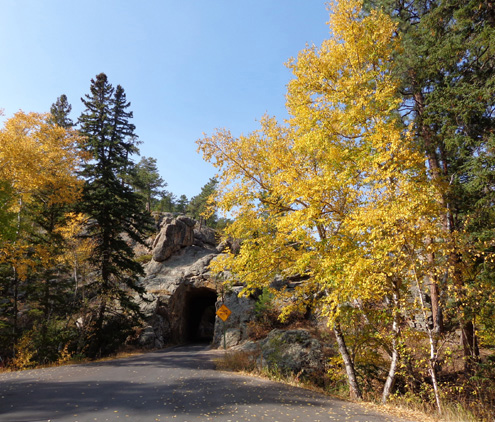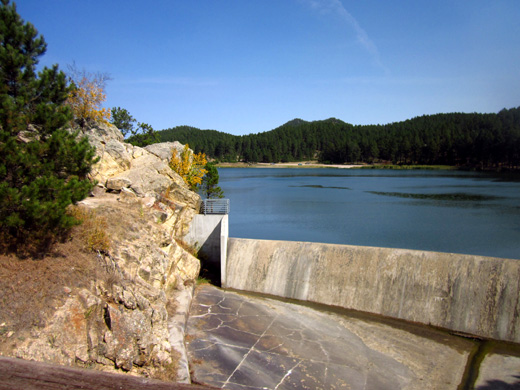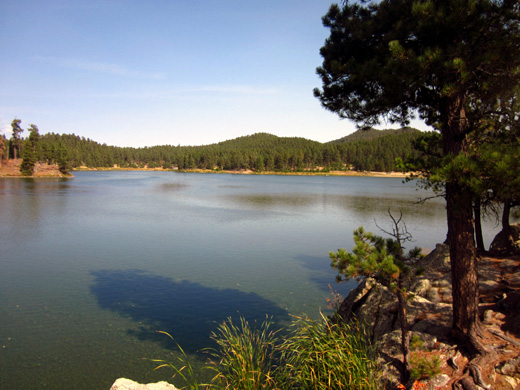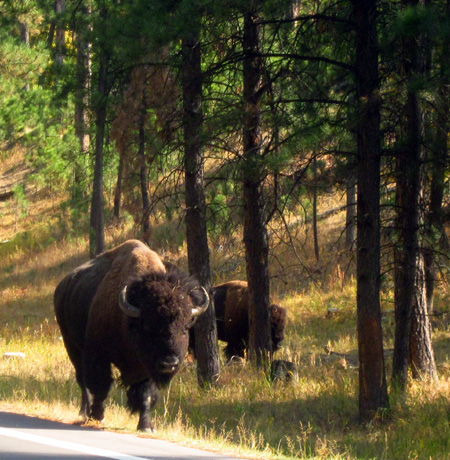This is the best state park we've ever visited, which is why we keep
coming back. It has everything we love -- thick forests,
mountains, interesting granite spires, lakes and streams, winding roads with tunnels and pigtail
bridges, lots of trails, and an abundance of wildlife including
free-roaming bison, elk, several kinds of deer, burros, bighorn sheep,
mountain goats, mountain lions, coyotes, and many smaller critters.

One of several narrow tunnels in Custer State Park
Today we both covered a lot of territory in the park -- Jim on
his bike, me on my feet and in the truck. I'll cover Jim's bike ride on
this page and my hike on subsequent pages.
MICKELSON TRAIL
This was another
perfectly beautiful, sunny day in the 60s and 70s F. with only a few
clouds and a little bit of wind. It was warmer in Rapid City and our campground at
Ellsworth AFB than it was down in the Black Hills, which are at a higher altitude.
We drove to Hill City via US 16 and 385. Jim got breakfast at Subway,
then began riding his bike from Hill City south to the town of Custer on the Mickelson Trail.
Here's a
map
section that shows Jim's route today:

Last year Jim rode
the entire 109-mile George S. Mickelson Trail in one day while I crewed
for him:

Scenic setting along the Mickelson Trail:
bench, rock wall, tunnel

Jim riding near the southern end of the trail
This is a beautiful
multi-use crushed rock rail-trail with interesting wooden bridges and
tunnels. It passes through scenic forested land, canyons, meadows,
and several small historic towns through the Black Hills.
Jim doesn't like to
stop to take photos when he's riding his bike but he obliged with a few
today. The first pictures he took were of the unfinished Crazy Horse
Memorial between Hill City and Custer:


Neither of us
has been back to the memorial itself but we've had good views from the bike trail.
Every year before the buffalo roundup at Custer
State Park there is a contest for artists to paint fiberglass bison. The
painted masterpieces are displayed in the town of Custer until they are
auctioned off during roundup weekend.
Jim took this picture of one of the bison in Custer today:

Someday I'd love to go to that auction, not to
buy a bison but to see who buys them and what kind of prices they
command. It's fun to see them displayed later on at businesses that
purchased them. The one shown above is in front of the Chamber of Commerce.
Here's a typical store you'll find in historic
Western tourist towns:

STOCKADE LAKE
Jim got off the main Mickelson Trail in Custer and rode east on the spur
trail to Stockade Lake in Custer State Park.
Along the way he spotted
this group of wild turkeys in a field:

Although the spur trail stops at the western end of the lake, the narrow
paved road around the lake is good for bike riding.
Jim took these photos as he rode around the lake :




By the lake he found this memorial to Anna Donna Tallent, the first
white woman to live in the Black Hills:

Ms. Tallent, a teacher and writer, moved from New York state to Custer,
South Dakota in 1874. The monument was erected by a group called the
Society of Black Hills Pioneers and Tallent's "many admirers."
CRITTERS AT CUSTER STATE PARK
After looping around
the lake Jim
rode about 12 miles on paved US 16a through
the park to the cabins near the Norbeck Visitor Center.
This road is more heavily traveled
but he didn't have any trouble with traffic. Most folks were going the
35-45 MPH speed limit so they could spot wildlife and enjoy the bright
fall colors.
Along the way Jim stopped to photograph these bison grazing
within feet of the highway:


Up to 1,300 bison live in the park in the spring and summer. This time
of year most of the large herd has been corralled in the southern part
of the park for the very popular annual Buffalo Roundup event that is
open to the public. About 15,000 people attended this year's staged
roundup on Monday the 24th.
In late September it's harder to find any bison wandering around like
this. These are probably older animals that won't be sold this fall or
produce any more offspring.

The bison herd is partially culled annually so the remaining animals
will be healthier. Rangers keep the numbers consistent with the
available natural food supply in the park during the winter. The bison
selected for the auction in November are purchased by both individuals
and businesses.
The several hundred bison that aren't sold are physically examined, vaccinated, branded,
sorted, and released to roam around the park again in October.
Babies born in the spring will increase the numbers in the herd up to about
1,300 animals again.
I attended the buffalo roundup last year. I highly recommend visitors
see this phenomenon at least once in their lifetimes. It's a great way
to turn an annual ranger chore into an exciting event.
COUNTING SHEEP
Jim patiently waited in the shade near the cabins for me to pick him up.
He enjoyed his 40-mile bike ride but the 1½-hour wait at the end for me to arrive
with the truck was understandably tiring . . .
At least he had some entertainment
while he waited for me. A group of more than a dozen bighorn sheep
wandered into his view, grazing near the cabins and another building:


I love these photos of the sheep parading in a long line past the building,
which looks like a little chapel:



The sheep were close
enough to hear his phone ring when I called him – and scattered in fear. I saw
them farther down the road as we were driving past the game lodge after
I picked Jim up.
I also saw about ten deer
in small groups as I drove on SD 87 through the park on my way to meet
Jim but I didn't see any large game while Cody and I were hiking.
Next entry: my hike around Sylvan Lake and up to Harney Peak
Happy trails,
Sue
"Runtrails & Company" - Sue Norwood, Jim O'Neil,
and Cody the ultra Lab
Previous
Next
© 2012 Sue Norwood and Jim O'Neil






















